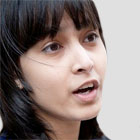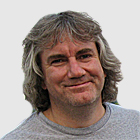But as the rumours persisted, and diplomats talked up the prospect of a large number of political prisoners being released, I could not help but start to hope. The UN has raised the case of my father with the government, and one UN body has ruled his detention is illegal. Dictatorships in Burma do regular prisoner amnesties, usually including some political prisoners. Perhaps this time he would be freed.
Since becoming president earlier this year, Thein Sein has played a clever political game. He has made promises of reform, and allowed slightly more political debate, and a slight relaxation of censorship. A steady drip, drip of small but seemingly positive steps has created an impression of change happening.
It would be a mistake, though, to think that Thein Sein is a moderate, as we understand the word. This is a man who was named by the UN special rapporteur on human rights in Burma in 1998 for ordering soldiers under his command to commit human rights abuses. In recent months he has sent his soldiers to the ethnic Shan and Kachin states, where they are gang-raping women and even children. Some are so brutally raped they die afterwards.
Thein Sein is not, as some claim, fighting a battle against hardliners, trying to bring democracy and human rights to Burma. His goal is continued dictatorship, but he appears more willing to make some compromises to get sanctions lifted, and to gain international legitimacy. I hoped that this would mean many political prisoners would be released.
This is a key practical benchmark for judging change. The US and EU have said that prisoners must be released before sanctions are lifted. Despite knowing Thein Sein isn't a genuine reformer, part of me still hoped that he would turn words into action and release most political prisoners, even if his motivations are not what he wants the world to believe. But he didn't.
It now appears that the number of political prisoners released will be in the low hundreds, leaving more than a thousand still in squalid jails, including my father. I am extremely disappointed, not just for myself, but for what this signifies for the prospects of change in my country.
Thein Sein appears to be trying to make the minimum amount of concessions to get the maximum in return. These releases will probably be enough to persuade the Association of Southeast Asian Nations (Asean) to allow Burma to take its turn as chair of the organisation in 2014. I hope that the British government, the EU and US will not be fooled by this token release, and start to relax sanctions. If they do relax sanctions, the pressure for further releases, and genuine reform will lessen.
Those freed from prison are not truly free. They live in a country that is still a dictatorship, even if it now has a civilian face. The repressive laws under which they were arrested remain in place. I still cannot safely return to my homeland. We will know change is coming when all political prisoners are released, when there is a nationwide ceasefire, not increased conflict and human rights abuses, and when there is a genuine dialogue process, which includes genuine ethnic representatives.
It is wonderful to see the prisoners who have been released, and for their families, but there are still so many families yet to be reunited. Like me, my mother had hoped against hope that my father would be released. She told herself not to get her hopes up, she has been disappointed too many times before. Yet she tidied the house just in case, and cooked a special meal, my father's favourite. In the end, my mother and sister had to eat the meal alone. More than a thousand other families had to do the same.
Some governments and observers have got carried away recently talking up prospects of change in Burma. I hope this will be a reality check for them. Burma's rulers have been lying to the international community for decades, always promising change is just round the corner. Some have fallen for the lies yet again. Until all prisoners are released and there is a nationwide ceasefire, don't believe the hype.
Russian cryptozoologists claiming to have evidence of the yeti will never be taken seriously without a more academic approach
 |
A claimed yeti footprint from 1951.
Photograph: Getty Images/Topical Press Agency
|
A common complaint among cryptozoologists – those who pursue unknown or folkloric monsters – is that mainstream science does not take their work seriously and inappropriately labels it as pseudoscience. The shenanigans currently going on in Russiaare a good example of why that happens. Gathered there, as the worldwide headlines have proclaimed, is a group of monster enthusiasts, having come together to investigate an upsurge in sightings in Russia of the yeti, or abominable snowman. Some of the participants in the hunt include a former Russian boxer turned politician, an American woman who claims a bigfoot family lives on her rural property, as well as an intrepid scientist or two. There also seems to be a political undercurrent and the usual hype by locals to boost tourism to their part of the world. And therein lies the rub.
One of the things the Russia monster project illuminates is the difference between science and pseudoscience: between real and fake science; between professional scientists and amateur investigators. Science does research thoroughly over long periods, checking and double checking to make sure they can prove their findings. Charles Darwin – who was essentially an amateur – waited decades before publishing his work on evolution to be sure he could support his argument. Such examples are legion. Science looks for evidence before headlines (though scientists have occasionally fallen prey to overly enthusiastic early reports prior to having established the basis of their work – remember cold fusion?).
Monster-hunting projects are nothing new in Russia. There is a robust history of searching for almas and almasti. These smaller cousins to the yeti are known from Russian folklore. They were sought in the early 20th century by Mongolian scholars Badzar Baradiin and Tsyben Žamcarano, later by Yöngsiyebü Rinčen. In 1958 the Soviet government organised a "snowman commission", which in turn sponsored an expedition to the Pamir mountains to follow up on sightings of the creatures there. Later, academics like the historian Boris Porshnev and medical doctor Marie-Jeanne Koffman became the revered parents of Russian monster-hunting. Their progeny, Dmitri Bayanov, Igor Bourtsev and others carry on the tradition.
Despite naysayers, the basic concept of cryptozoology is not pseudoscientific. Unknown animals are found on a regular basis by biologists and zoologists, and there is a long history of learned scholars engaging with the concept of monstrous creatures as well. From Aristotle to Pliny to Linnaeus to Richard Owen and Darwin, naturalists have investigated monsters and still do. Darwin thought they might be able to shed light on questions of generation and transmutation. One thing going for cryptozoologists is that creatures like the yeti or bigfoot have a greater theoretical evolutionary plausibility than, say, werewolves or the Jersey devil.
There is no problem with looking for monsters; the problem is how you go about it. That is the issue of contention in Russia. You need evidence. Assertions, claims and headlines alone are not enough. Vague bits of hair and odd footprints found in a cave on a publicity stunt do not constitute evidence. Supporters of intelligent design creationism try the same thing. They want to skip all the workaday effort that goes into science and jump straight to the point where their ideas are accepted.
There are a number of cryptozoologists who work diligently at being properly scientific. They go about their work with intelligence as well as energy. While mostly amateurs, they embody the essence of the scientific endeavour: search the unknown. They, however, are regularly undermined by their less academic brethren. This condition shows that rather than mainstream science it is cryptozoologists themselves who often toss the monkey wrench (or should we say yeti wrench) into the works.
If the yeti or bigfoot or any of their kin do exist out there, someday they will be found, and likely by an amateur rather than a professional scientist. If that day arrives all of us sceptics will have to rethink our positions. Until then, if cryptozoologists want to be taken seriously by scientists they need to behave more like scientists and less like carnival barkers. Keep the circus to a minimum until you actually have a yeti to show the world, then respect will come.
@ The Guardian
@ The Guardian




